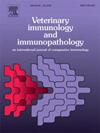Further assessment of the binding properties of proteins A, G, and chimeric protein AG to immunoglobulins of multiple host species of marine mammals
IF 1.4
3区 农林科学
Q4 IMMUNOLOGY
引用次数: 0
Abstract
Detection of infectious diseases in marine mammals is crucial to reduce the risk of transmission of zoonotic pathogens to humans. Although serodiagnostic tests such as enzyme-linked immunosorbent assay (ELISA) can detect antibodies against such pathogens, commercial secondary antibodies specific to marine mammal species are limited. Proteins A and AG have been previously found to react strongly to the immunoglobulins of pinnipeds and cetaceans. However, the binding properties of immunoglobulins of other marine mammals remain unclear to these proteins. Using ELISA, this study further assessed the binding properties of proteins A, G, and AG in detecting immunoglobulins in marine mammals such as marine fissipeds and sirenians (grouped together ecologically but not taxonomically). Sera/plasmas from two marine fissipeds (polar bears and sea otters), one sirenian (manatees), one pinniped (grey seals), and four cetaceans (Commerson’s dolphins, false killer whales, finless porpoises, and pantropical spotted dolphins) were collected. The results revealed that the immunoglobulins of these marine mammals bound more strongly to proteins A and AG than to protein G, indicating a strong signal intensity in ELISA and a strong antibody-protein complex reaction. This study thus suggests that proteins A and AG can be used as secondary antibodies to detect immunoglobulins against infectious agents in multiple host species of marine mammals in serodiagnostic tests, thereby preventing the transmission of infectious agents from marine mammals to humans.
进一步评估蛋白A、G和嵌合蛋白AG与多种海洋哺乳动物宿主免疫球蛋白的结合特性
在海洋哺乳动物中检测传染病对于减少人畜共患病原体向人类传播的风险至关重要。尽管诸如酶联免疫吸附试验(ELISA)之类的血清诊断测试可以检测出针对这些病原体的抗体,但针对海洋哺乳动物物种的商业二抗有限。蛋白质A和AG已被发现对鳍足类和鲸类动物的免疫球蛋白有强烈反应。然而,其他海洋哺乳动物免疫球蛋白与这些蛋白的结合特性尚不清楚。本研究利用酶联免疫吸附试验(ELISA)进一步评估了A、G和AG蛋白在海洋哺乳动物(如海洋裂足动物和海螺动物)免疫球蛋白检测中的结合特性。收集了两种海洋裂足动物(北极熊和海獭),一种海牛(海牛),一种鳍足动物(灰海豹)和四种鲸目动物(康默森海豚,假虎鲸,无鳍鼠海豚和热带斑点海豚)的血清/血浆。结果表明,这些海洋哺乳动物的免疫球蛋白与蛋白A和AG的结合比与蛋白G的结合更强,在ELISA中显示出较强的信号强度和较强的抗体-蛋白复合物反应。因此,本研究表明,在血清诊断试验中,蛋白A和AG可作为检测多种海洋哺乳动物宿主体内针对感染因子的免疫球蛋白的二抗,从而防止感染因子从海洋哺乳动物传播给人类。
本文章由计算机程序翻译,如有差异,请以英文原文为准。
求助全文
约1分钟内获得全文
求助全文
来源期刊
CiteScore
3.40
自引率
5.60%
发文量
79
审稿时长
70 days
期刊介绍:
The journal reports basic, comparative and clinical immunology as they pertain to the animal species designated here: livestock, poultry, and fish species that are major food animals and companion animals such as cats, dogs, horses and camels, and wildlife species that act as reservoirs for food, companion or human infectious diseases, or as models for human disease.
Rodent models of infectious diseases that are of importance in the animal species indicated above,when the disease requires a level of containment that is not readily available for larger animal experimentation (ABSL3), will be considered. Papers on rabbits, lizards, guinea pigs, badgers, armadillos, elephants, antelope, and buffalo will be reviewed if the research advances our fundamental understanding of immunology, or if they act as a reservoir of infectious disease for the primary animal species designated above, or for humans. Manuscripts employing other species will be reviewed if justified as fitting into the categories above.
The following topics are appropriate: biology of cells and mechanisms of the immune system, immunochemistry, immunodeficiencies, immunodiagnosis, immunogenetics, immunopathology, immunology of infectious disease and tumors, immunoprophylaxis including vaccine development and delivery, immunological aspects of pregnancy including passive immunity, autoimmuity, neuroimmunology, and transplanatation immunology. Manuscripts that describe new genes and development of tools such as monoclonal antibodies are also of interest when part of a larger biological study. Studies employing extracts or constituents (plant extracts, feed additives or microbiome) must be sufficiently defined to be reproduced in other laboratories and also provide evidence for possible mechanisms and not simply show an effect on the immune system.

 求助内容:
求助内容: 应助结果提醒方式:
应助结果提醒方式:


